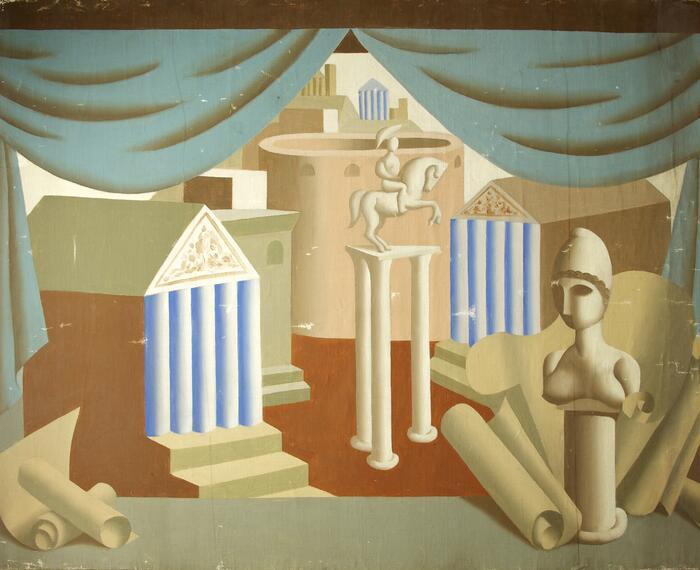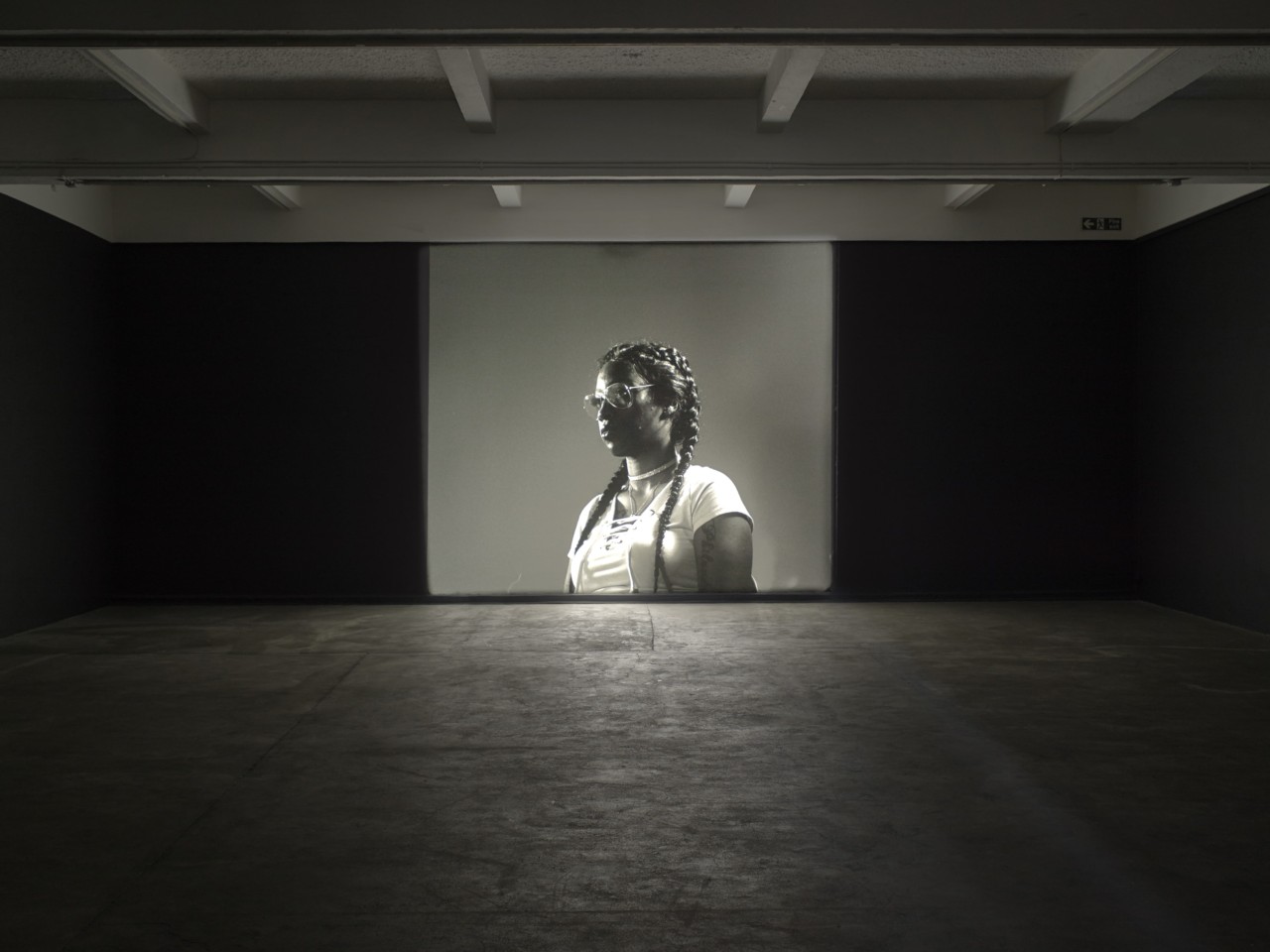


Luke Willis Thompson, autoportrait, (2017). Installation view, Chisenhale Gallery 2017. Commissioned by Chisenhale Gallery and produced in partnership with Create. Courtesy of the artist. Photo: Andy Keate.
The Chisenhale Gallery is dark except for the projected image of a woman floating on one wall, throbbing, breathing with the sound of the large projector behind. Captured in luminous black and white 35 mm film, she is seated at a three-quarter angle, cropped at her shoulder. She sings solemnly to herself, eyes cast down. Light reflects off her left cheek, her hair is in braids, she wears a sparkling white choker. You may not initially recognise her. In the second shot the camera has pulled back and reveals a tattoo on her arm, a memorial to her partner Philando Castile. This woman is Diamond Reynolds, whose courage and dignity is celebrated in this sublime work. The footage she livestreamed on Facebook, of the moments after Castile was shot by a police officer during a traffic stop in Minnesota, with their four-year-old daughter in the car, has been viewed nine million times. Thompson’s film was made while Reynolds’ life was in suspended animation awaiting the trial of the officer, Jeronimo Yanez. Shockingly, just days before this exhibition opened, he was acquitted on all charges.
In autoportrait (2017) Thompson has created an image of Reynolds, with her active collaboration, as a ‘sister’ image to her camera-phone footage. He wants to scramble the logic around media depictions of race, class, and poverty. Here Reynolds has ultimate control over her image, the work can only be screened on a 35 mm film projector and cannot circulate easily online. The pacing is calm, each shot runs for four and a half minutes, the length of a roll of film. The depth of the 35 mm film stock, cinema’s most canonical form, elicits an emotional response, its resolution and grain in contrast to the pixilation of digital footage. The film is silent, in contrast to traditional media platforms on which the subject is made to relive the trauma on screen.
This is the New Zealander’s first solo exhibition in the UK and a chance for local audiences to get to know one of the most brilliant artists of his generation. autoportrait was produced during Thompson’s 2016-17 Chisenhale Gallery Create Residency, alongside another film work, Cemetery of Uniforms and Liveries (2016). These portraits of two men, whose maternal relatives were victims of police brutality in their own homes, were filmed on 16mm film and transferred to video. Also silent, these young men look at the camera steadily without moving. Brandon is the grandson of Dorothy ‘Cherry’ Groce, whose shooting sparked the Brixton riots in 1985. Graeme is the son of Joy Gardner, who was gagged and suffocated during a police raid in Crouch End in 1993: the officers responsible were acquitted. Again these films bestow dignity on their subjects and offer a counterpoint to the single circulating images of their relatives in the media. Thompson also subverts the genres of mugshots, colonial era photography and criminal physiognomy. He uses Kodak Tri-X Black and White Reversal, the same Andy Warhol used for his Screen Tests 1963-66, to which he pays homage whilst critiquing their whiteness.
These works evolved out of Thompson’s much-admired performance Eventually they introduced me to the people I immediately recognized as those who would take me out anyway (2015) for the New Museum Triennial. In it visitors were invited to follow performer-guides out of the museum into the streets of New York, onto the subway and out to the Boroughs, on a silent tour to sites of racial tension. Occasionally the performers would glance back at the followers and make eye contact, disconcerting them. By taking them out of the museum, the artist invites the audience to see the world as a readymade.
For Thompson, what happens outside the gallery is infinitely more interesting than what happens within. In an earlier work, inthisholeonthisislandandwhereiam (2012-14) visitors were collected from an empty gallery in taxis. They were driven to a suburban house, which they could wander around at leisure while it gradually sunk in that this might be the artist’s family home.
In his practice, Thompson investigates the treatment of minority communities and the way objects and sites can be imbued with violence. In his installation Misadventure (2012), the artist presents evidence of the death of a Maori teenager, Pihema Cameron, who was stabbed to death when tagging garage doors by their white vigilante owner. Thompson acquired and exhibited the three tagged garage doors and they have since entered the collection of Auckland Art Gallery.
Thompson poetically explores the import and export of people and goods between cultures, as well as sites of trauma and memory. During his 2014 residency at Weltkulturen Museum in Frankfurt, Thompson researched the questions around the repatriation of objects and human remains in ethnographic collections. Ultimately he decided to use his production budget to pay for the repatriation of a dead person from Frankfurt to their home country. Inversely, in Sucu Mate/Born Dead (2016) he borrowed and displayed nine gravestones in a gallery. These were taken from the site of a former sugar plantation in Fiji and marked the burial sites of anonymous indentured labourers from India and China who died there after toiling in brutal conditions.
Born in Auckland in 1988 to a New Zealand mother and a Fijian father, Thompson lives and works in London. He studied at Elam School of Fine Arts, Auckland and Städelschule, Frankfurt. Selected solo shows include Cemetery of Uniforms and Liveries, Galerie Nagel Draxler, Berlin; Sucu Mate/Born Dead, Hopkinson Mossman, Auckland; and Misadventure, IMA Brisbane (all 2016). Recent group exhibitions include Sao Paulo Biennale and Montreal Biennale (both 2016); Asia Pacific Triennial at the Queensland Art Gallery, Queensland; and Surround Audience: New Museum Triennial 2015, New Museum, New York (both 2015). Thompson was awarded the Walters’ Prize in 2014.